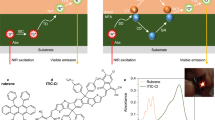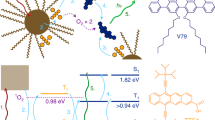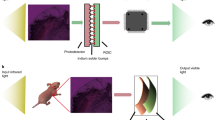Abstract
The energy of photons, that is, the wavelength of light, can be upgraded through interactions with materials in a process called photon upconversion1. Although upconversion in organic solids is important for various applications, such as photovoltaics and bioimaging, conventional upconversion systems, based on intersystem crossing (ISC), suffer from low efficiency2,3,4,5,6. Here we report a novel upconversion system with heterojunctions of organic semiconductors. The upconversion occurs through charge separation and recombination, which mediate charge transfer states at the interface. This process can efficiently convert the incident photons to triplets without relying on ISC, which is typically facilitated by the heavy-atom effect1. As a result, a solid-state upconversion system is achieved with an external efficiency that is two orders of magnitude higher than those demonstrated by conventional systems6. Using this result, efficient upconversion, from near-infrared to visible light, can be realized on flexible organic thin films under a weak light-emitting-diode-induced excitation, observable by naked eyes.
This is a preview of subscription content, access via your institution
Access options
Access Nature and 54 other Nature Portfolio journals
Get Nature+, our best-value online-access subscription
$29.99 / 30 days
cancel any time
Subscribe to this journal
Receive 12 print issues and online access
$209.00 per year
only $17.42 per issue
Buy this article
- Purchase on Springer Link
- Instant access to full article PDF
Prices may be subject to local taxes which are calculated during checkout




Similar content being viewed by others
Data availability
The main data supporting the findings of this study are available within the article and its Supplementary Information. Extra data are available from the corresponding authors on reasonable request.
References
Zhou, J., Liu, Q., Feng, W., Sun, Y. & Li, F. Upconversion luminescent materials: advances and applications. Chem. Rev. 115, 395–465 (2015).
Gray, V., Moth-Poulsen, K., Albinsson, B. & Abrahamsson, M. Towards efficient solid-state triplet-triplet annihilation based photon upconversion: supramolecular, macromolecular and self-assembled systems. Coord. Chem. Rev. 362, 54–71 (2018).
Joarder, B., Yanai, N. & Kimizuka, N. Solid-state photon upconversion materials: structural integrity and triplet-singlet dual energy migration. J. Phys. Chem. Lett. 9, 4613–4624 (2018).
Tan, G.-R., Wang, M., Hsu, C.-Y., Chen, N. & Zhang, Y. Small upconverting fluorescent nanoparticles for biosensing and bioimaging. Adv. Opt. Mater. 4, 984–997 (2016).
Bharmoria, P., Bildirir, H. & Moth-Poulsen, K. Triplet-triplet annihilation based near infrared to visible molecular photon upconversion. Chem. Soc. Rev. 49, 6529–6554 (2020).
Lin, T. A., Perkinson, C. F. & Baldo, M. A. Strategies for high-performance solid-state triplet-triplet-annihilation-based photon upconversion. Adv. Mater. 32, e1908175 (2020).
Singh-Rachford, T. N. & Castellano, F. N. Photon upconversion based on sensitized triplet-triplet annihilation. Coord. Chem. Rev. 254, 2560–2573 (2010).
Zhou, Y., Castellano, F. N., Schmidt, T. W. & Hanson, K. On the quantum yield of photon upconversion via triplet-triplet annihilation. ACS Energy Lett. 5, 2322–2326 (2020).
Niihori, Y., Wada, Y. & Mitsui, M. Single platinum atom doping to silver clusters enables near-infrared-to-blue photon upconversion. Angew. Chem. Int. Ed. 60, 2822–2827 (2021).
Harada, N., Sasaki, Y., Hosoyamada, M., Kimizuka, N. & Yanai, N. Discovery of key TIPS-naphthalene for efficient visible-to-UV photon upconversion under sunlight and room light. Angew. Chem. Int. Ed. 60, 142–147 (2021).
Wu, M. et al. Solid-state infrared-to-visible upconversion sensitized by colloidal nanocrystals. Nat. Photon. 10, 31–34 (2015).
Ogawa, T. et al. Donor-acceptor-collector ternary crystalline films for efficient solid-state photon upconversion. J. Am. Chem. Soc. 140, 8788–8796 (2018).
Nakano, K. & Tajima, K. Organic planar heterojunctions: from models for interfaces in bulk heterojunctions to high-performance solar cells. Adv. Mater. 29, 1603269 (2017).
Sarma, M. & Wong, K. T. Exciplex: an intermolecular charge-transfer approach for TADF. ACS Appl. Mater. Interfaces 10, 19279–19304 (2018).
Pandey, A. K. Highly efficient spin-conversion effect leading to energy up-converted electroluminescence in singlet fission photovoltaics. Sci. Rep. 5, 7787 (2015).
Firdaus, Y. et al. Long-range exciton diffusion in molecular non-fullerene acceptors. Nat. Commun. 11, 5220 (2020).
Groff, R. P., Merrifield, R. E., Suna, A. & Avakian, P. Magnetic hyperfine modulation of dye-sensitized delayed fluorescence in an organic crystal. Phys. Rev. Lett. 29, 429–431 (1972).
Rao, A. et al. The role of spin in the kinetic control of recombination in organic photovoltaics. Nature 500, 435–439 (2013).
Yuan, J. et al. Single-junction organic solar cell with over 15% efficiency using fused-ring acceptor with electron-deficient core. Joule 3, 1140–1151 (2019).
Zhang, H. et al. Over 14% efficiency in organic solar cells enabled by chlorinated nonfullerene small-molecule acceptors. Adv. Mater. 30, e1800613 (2018).
Hiramoto, M., Kikuchi, M. & Izawa, S. Parts-per-million-level doping effects in organic semiconductor films and organic single crystals. Adv. Mater. 31, e1801236 (2019).
Kalyanasundaram, K. & Nazeeruddin, M. K. Tuning of the CT excited state and validity of the energy gap law in mixed ligand complexes of Ru(II) containing 4,4′-dicarboxy-2,2′-bipyridine. Chem. Phys. Lett. 193, 292–297 (1992).
Benduhn, J. et al. Intrinsic non-radiative voltage losses in fullerene-based organic solar cells. Nat. Energy 2, 17053 (2017).
Englman, R. & Jortner, J. The energy gap law for radiationless transitions in large molecules. Mol. Phys. 18, 145–164 (1970).
Monguzzi, A., Mezyk, J., Scotognella, F., Tubino, R. & Meinardi, F. Upconversion-induced fluorescence in multicomponent systems: steady-state excitation power threshold. Phys. Rev. B 78, 195112 (2008).
Ronchi, A. et al. Triplet-triplet annihilation based photon up-conversion in hybrid molecule-semiconductor nanocrystal systems. Phys. Chem. Chem. Phys. 21, 12353–12359 (2019).
Ronchi, A. et al. High photon upconversion efficiency with hybrid triplet sensitizers by ultrafast hole-routing in electronic-doped nanocrystals. Adv. Mater. 32, e2002953 (2020).
Abulikemu, A. et al. Solid-state, near-infrared to visible photon upconversion via triplet-triplet annihilation of a binary system fabricated by solution casting. ACS Appl. Mater. Interfaces 11, 20812–20819 (2019).
Clarke, T. M. & Durrant, J. R. Charge photogeneration in organic solar cells. Chem. Rev. 110, 6736–6767 (2010).
Proctor, C. M., Albrecht, S., Kuik, M., Neher, D. & Nguyen, T.-Q. Overcoming geminate recombination and enhancing extraction in solution-processed small molecule solar cells. Adv. Energy Mater. 4, 1400230 (2014).
Vandewal, K. et al. Efficient charge generation by relaxed charge-transfer states at organic interfaces. Nat. Mater. 13, 63–68 (2014).
Izawa, S., Nakano, K., Suzuki, K., Hashimoto, K. & Tajima, K. Dominant effects of first monolayer energetics at donor/acceptor interfaces on organic photovoltaics. Adv. Mater. 27, 3025–3031 (2015).
Perdigon-Toro, L. et al. Barrierless free charge generation in the high-performance PM6:Y6 bulk heterojunction non-fullerene solar cell. Adv. Mater. 32, e1906763 (2020).
Foertig, A. et al. Nongeminate recombination in planar and bulk heterojunction organic solar cells. Adv. Energy Mater. 2, 1483–1489 (2012).
Shintaku, N., Hiramoto, M. & Izawa, S. Effect of trap-assisted recombination on open-circuit voltage loss in phthalocyanine/fullerene solar cells. Org. Electron. 55, 69–74 (2018).
Johnson, R. C. & Merrifield, R. E. Effects of magnetic fields on the mutual annihilation of triplet excitons in anthracene crystals. Phys. Rev. B 1, 896–902 (1970).
Kawashima, K., Tamai, Y., Ohkita, H., Osaka, I. & Takimiya, K. High-efficiency polymer solar cells with small photon energy loss. Nat. Commun. 6, 10085 (2015).
Ran, N. A. et al. Harvesting the full potential of photons with organic solar cells. Adv. Mater. 28, 1482–1488 (2016).
Yanai, N. & Kimizuka, N. New triplet sensitization routes for photon upconversion: thermally activated delayed fluorescence molecules, inorganic nanocrystals and singlet-to-triplet absorption. Acc. Chem. Res. 50, 2487–2495 (2017).
Huang, Z., Simpson, D. E., Mahboub, M., Li, X. & Tang, M. L. Ligand enhanced upconversion of near-infrared photons with nanocrystal light absorbers. Chem. Sci. 7, 4101–4104 (2016).
Di, D. et al. Efficient triplet exciton fusion in molecularly doped polymer light-emitting diodes. Adv. Mater. 29, 1605987 (2017).
Izawa, S., Shintaku, N., Kikuchi, M. & Hiramoto, M. Importance of interfacial crystallinity to reduce open-circuit voltage loss in organic solar cells. Appl. Phys. Lett. 115, 153301 (2019).
Acknowledgements
This research was supported in part by JSPS KAKENHI, Grant-in-Aid for Young Scientists no. 18K14115 (S.I.), the Mazda Foundation (S.I.), the Kao Foundation for Arts and Sciences (S.I.) and Konica Minolta Science and Technology Foundation (S.I.). We thank T. Ueda from the Instrument Center in the Institute for Molecular Science for his assistance with most of the optical measurements. We thank K. Tajima and K. Nakano (RIKEN) for assistance with the highly sensitive EQE measurements of photovoltaic devices. We also thank K. Tajima (RIKEN) and M. Takahashi (Shizuoka University) for their valuable comments.
Author information
Authors and Affiliations
Contributions
S.I. directed the project, conceived the idea, designed and performed the experiments and wrote the paper. M.H. supervised the research. Both authors reviewed the manuscript.
Corresponding author
Ethics declarations
Competing interests
The authors declare no competing interests.
Additional information
Peer review information Nature Photonics thanks the anonymous reviewers for their contribution to the peer review of this work.
Publisher’s note Springer Nature remains neutral with regard to jurisdictional claims in published maps and institutional affiliations.
Supplementary information
Supplementary Information
Materials and Methods, Supplementary Figs. 1–7, Tables 1 and 2 and Discussion.
Rights and permissions
About this article
Cite this article
Izawa, S., Hiramoto, M. Efficient solid-state photon upconversion enabled by triplet formation at an organic semiconductor interface. Nat. Photon. 15, 895–900 (2021). https://doi.org/10.1038/s41566-021-00904-w
Received:
Accepted:
Published:
Issue Date:
DOI: https://doi.org/10.1038/s41566-021-00904-w
This article is cited by
-
Near-infrared photon upconversion and solar synthesis using lead-free nanocrystals
Nature Photonics (2023)
-
Blue organic light-emitting diode with a turn-on voltage of 1.47 V
Nature Communications (2023)
-
Triplet sensitization via charge recombination at organic heterojunction for efficient near-infrared to visible solid-state photon upconversion
Communications Materials (2022)



